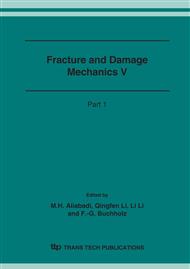p.251
p.255
p.259
p.263
p.267
p.271
p.275
p.279
p.283
Fracture Analysis on the Interface Crack of Concrete Gravity Dam
Abstract:
Some numerical parameters-sensitivity analysis has been conducted to evaluate the stability and propagation of the interface cracks at heel of concrete gravity dam. In this paper, utilizing the software ANSYS to simulate the stress and displacement fields of the tip of the interface cracks between concrete gravity dam and foundation, the stress intensity factor (SIF) of the interface crack is analyzed using facture mechanics. Three impacting factors have been discussed, such as the crack length, the angle of crack, and the water height. Critical length and loads of interface crack propagation are obtained using composite fracture criteria. The results indicate that the coarse interface retards the propagation of interface crack, and redounds to stability of gravity dam. It is found that the interface crack often propagates alone the interface between dam and foundation, simultaneously the branch crack kinks to foundation at the specific condition.
Info:
Periodical:
Pages:
267-270
Citation:
Online since:
November 2006
Authors:
Price:
Сopyright:
© 2006 Trans Tech Publications Ltd. All Rights Reserved
Share:
Citation:


